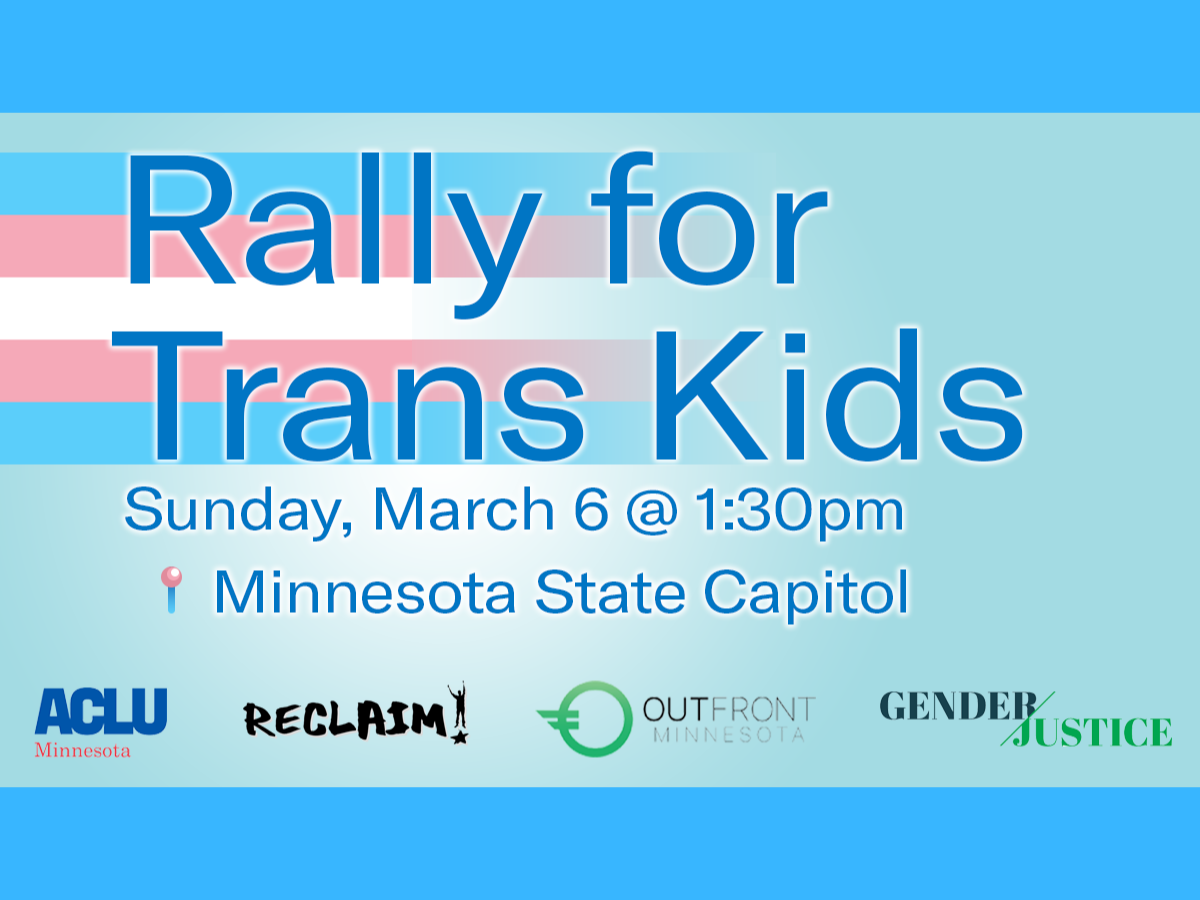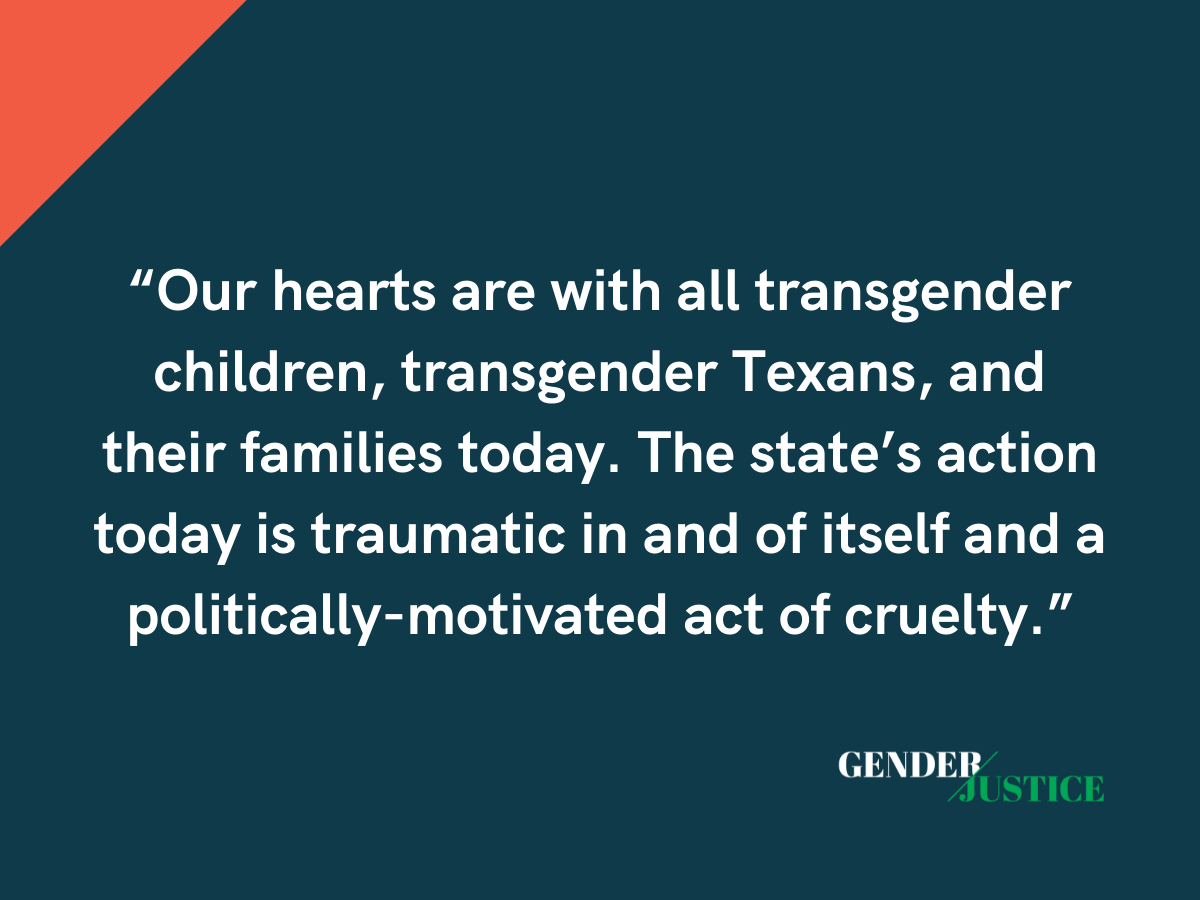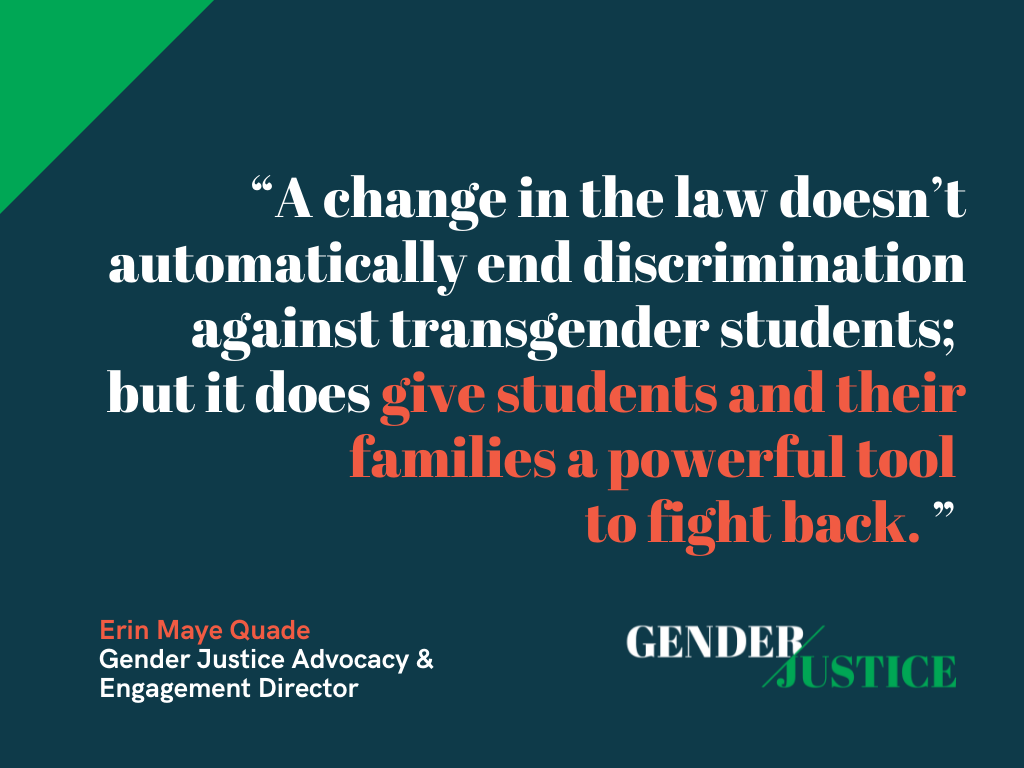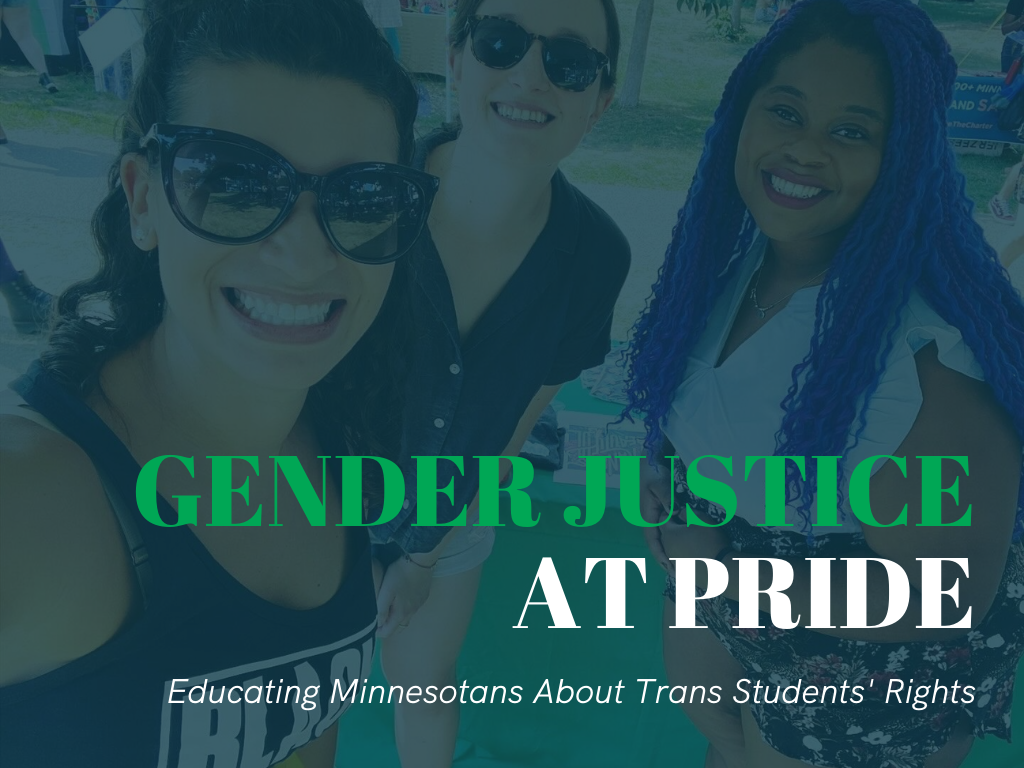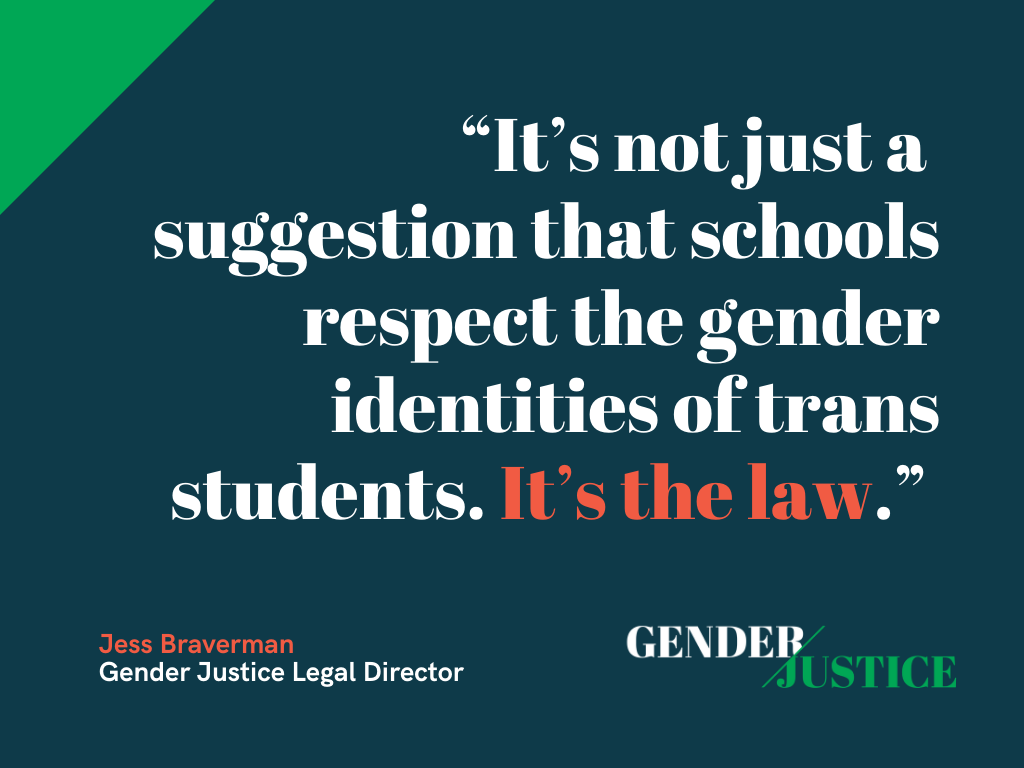
Safe Schools for Trans Students
How We Make Change
What We Fight For
Where Barriers Occur
When David and Hannah Edwards enrolled their child, H.E. (who now goes by Hildie and uses they/them pronouns), at Nova Classical Academy for the 2015 – 2016 school year, they believed it would be a good place for them to learn and thrive. At the time, their child presented as a gender non-conforming boy—that is, as a boy who preferred clothing and activities often associated with girls. David and Hannah were open with the school about their child’s evolving gender identity at the time of enrollment and began working with the school when their daughter enrolled at Nova to protect her from bullying and discrimination.
Unfortunately, while Nova staff took initial steps to create a supportive environment for trans students, its leadership repeatedly blocked or delayed positive actions. As a result, the Edwardses’ daughter experienced bullying because of her gender identity and her ability to transition socially at school in a timely and supported manner was denied.

READ MORE ABOUT THE EDWARDS FAMILY’S EXPERIENCE AT NOVA
-
July 2017 Complaint, which was served on Nova but not filed
-
May 2017 Probable Cause Finding from the City of Saint Paul
-
March 2016 Charge filed with the City of Saint Paul’s Human Rights Division
-
July 2016 Rebuttal Letter to City of Saint Paul
-
December 2016 Supplemental Letter 1 to City of Saint Paul
-
January 2017 Supplemental Letter 2 to City of Saint Paul
-
TRANS YOUTH DESERVE EQUAL ACCESS TO EDUCATION IN A SAFE ENVIRONMENT
The effects of the harms imposed on trans youth by gender-based bullying and the lack of clear responses from institutions are well-documented: rates of depression and suicide among trans youth are disproportionately high: 55.4% of all Minnesota transgender children have attempted suicide within the previous two years according to the 2016 Minnesota Student Survey.
Less well understood by the public are what those harms look like for and how they manifest in grade-school aged children.
“H.E. knows there’s a place in the world where she’s not welcome,” says David Edwards. “She told me, ‘they never believed I was a girl.’ That’s not something a five-year-old should know, that there’s a place where people won’t let you be you, and they make sure to tell you daily that you can’t be you.”
These harms last. “She learned that people could hurt her, that part of her was fair game and that the adults who were supposed to protect her wouldn’t do anything about it,” says Hannah Edwards. “Now, when she’s upset or hurt at school, she won’t always tell the adults in charge. She doubts she’ll be believed. This makes her even more vulnerable.”
With Gender Justice’s assistance, the Edwardses did everything they could to help the school do the right thing. As educators themselves, David and Hannah understand the context and know best practices.
After the school refused to read an age-appropriate book, My Princess Boy, “we kept asking ourselves, ‘How do we get them to do the right thing?’” recalls Hannah Edwards. “We called OutFront Minnesota and Transforming Families and posted a query on an online forum. Someone said, ‘Call Gender Justice.’ I called and gave them the whole spiel over the phone. Jill [Gaulding, Gender Justice’s co-founder and former senior counsel] called back within 30 minutes and started coming to meetings with us immediately and giving us free legal advice.
Every step of the way, they’d say, ‘This is a decision point. These are your options.’ I don’t think we could have made it through without them. I can’t imagine having tried to go anywhere else.”
Schools that don’t comply with state and federal civil rights statutes not only put their trans students’ lives at risk but also invite public controversy and media scrutiny. No one wants to be ‘that school.’ The City of Saint Paul found that failure to correct and prevent a hostile school climate for trans students constitutes discrimination. It is up to every school to ensure transgender students have access to an education that is safe, no matter the circumstances.
POLICY CHANGES SECURED THROUGH SETTLEMENT
In July 2017, the Edwardses’ legal complaint against Nova was resolved through a confidential mediation process. Read our announcement about the settlement.
Under the terms of the settlement agreement, Nova will pay damages of $120,000 to Hannah and David Edwards and their minor child, H.E., and revise its policies and practices to support its transgender and gender nonconforming students. The Edwards family agreed not to pursue a lawsuit against the school.
This agreement is a victory for trans and gender nonconforming children at Nova, and it clarifies for school leaders what it looks like to create an authentically supportive environment for all kids.
Nova will make specific policy changes that create a generally trans-friendly environment instead of one determined on a case-by-case basis. Its new Gender Inclusion Guidelines include specific language around name and pronoun changes, changes in appearance, and differences in associations such as gendered groups; providing a safe, welcoming, and affirming environment; supporting the child’s timeline for social transition.
It will also include the Minnesota Department of Education’s Toolkit in its staff resources; set clear expectations for respectful, nondiscriminatory dialogue in board meetings, provide professional development to staff, and will not allow students or families to “opt-out” of following the gender inclusion policy.
Read more about the policy changes secured through the settlement agreement.
GENDER JUSTICE’S ROLE
The Edwards family is represented by Gender Justice. Co-Founder and former Senior Counsel, Jill Gaulding and former Robina Fellow, Kristin Johnson were instrumental in advocating for the Edwards family. Co-Founder and Senior Counsel, Lisa Stratton, and Staff Attorney Christy Hall shepherded the Edwardses through mediation to a successful settlement.
“This would have been a longer, nastier process if we hadn’t had legal representation,” says David Edwards. “Gender Justice gave us a support system which allowed us to advocate for our kid without falling apart. Just having someone say that they heard the same nonsense as you did was a huge relief.”
Gender Justice does more than file lawsuits. Our attorneys were there for the Edwardses long before there was a legal case. In addition to offering support and advice, Gender Justice helped to organize a critical demonstration of community support for the Edwards family at a forum organized by the anti-LGBTQ organization Minnesota Family Council in January of 2016 at the school. Working with OutFront Minnesota and Transforming Families, we were able to turn out allies to advocate for safe and inclusive schools.
MINNESOTA CONTEXT
Nearly 3% of Minnesota students self-identify as gender diverse. According to the most recent scientific research, children as young as three already have a strong sense of their gender identity, regardless of whether they are transgender or cisgender. Gender transition before puberty doesn’t require a medical intervention such as hormones or surgery. Instead, children may socially transition by using the name and pronouns they prefer. They may also wish to present their appearance and otherwise express their gender in ways typically associated with their gender identity.
The research also shows that when adults allow transgender children to transition socially before puberty, however, these children have essentially the same levels of depression and only marginally higher rates of anxiety than their cisgender siblings and peers.
Trans-friendly policies and practices are not only the law for public schools but are quickly becoming the norm. Many Minnesota schools already have proactive policies and practices in place which protect transgender students from bullying and create safe learning environments for all.
“Districts that are doing the right thing are having a much more positive experience,” says Hannah Edwards. “St. Paul Public Schools experienced backlash when they were developing their policies but now their teachers and kids are having a different experience than we had at Nova.”
H.E., now a seven-year-old in a St. Paul Public School, shared her (previously undisclosed) gender identity with her classmates at the end of last school year after her teacher read I am Jazz to her class and explained the school’s expectations around respecting trans and gender nonconforming students. Her experience in the St. Paul school system has been dramatically better – an example of how meaningful policies affect outcomes.
In 2015 the Minnesota State High School League passed a policy allowing student-athletes to play for the teams and use the locker rooms that match their gender identity.
St. Paul Public Schools subsequently approved a gender inclusion policy in March 2015 which compels staff in the school district to respect students’ gender identity and provide them with access to facilities that best align with that identity.
“The Minnesota Family Council would have school leaders believe that parents can sue them for protecting trans rights,” says Hannah Edwards. “But we don’t know of any instance nationally in which a cisgender kid’s family has sued a school district and won.”
Gender Justice is here to support families and to remind Minnesota schools that they are not in this alone. Schools don’t need to reinvent the wheel. There are tools available already to protect trans and gender nonconforming students.
News Updates
LEARN MORE ABOUT ENSURING SAFE AND WELCOMING SCHOOLS
The Minnesota Department of Education recently made available a “Toolkit for Ensuring Safe and Supportive Schools for Transgender and Gender Nonconforming Students,” on its website. It outlines federal and state laws and offers guidelines on working with parents, community, and school officials; managing names, pronouns, and student records; handling school athletics and social events; and dealing with dress codes, restrooms, and locker rooms. The Human Rights Campaign Foundation’s Welcoming Schools website is also a valuable resource.
You Can Help.
Donate
With your financial support, Gender Justice can continue to fight hard for our clients and push the laws forward in our legislature. Be there with us as we work to bring about big, systemic change. Give today.

